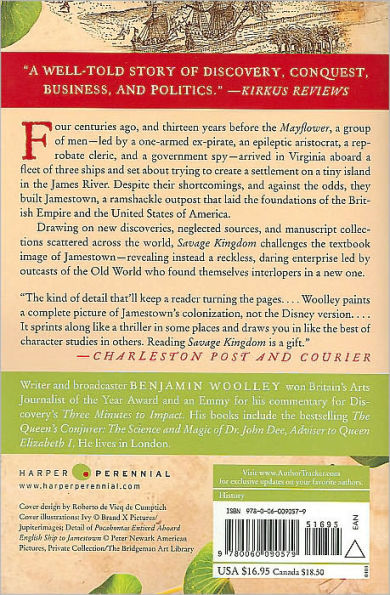Four centuries ago, and fourteen years before the Mayflower, a group of men—led by a one-armed ex-pirate, an epileptic aristocrat, a reprobate cleric and a government spy—left London aboard a fleet of three ships to start a new life in America. They arrived in Virginia in the spring of 1607 and set about trying to create a settlement on a tiny island in the James River. Despite their shortcomings, and against the odds, they built Jamestown, a ramshackle outpost that laid the foundations of the British Empire and the United States of America.
Drawing on new discoveries, neglected sources and manuscript collections scattered across the world, Savage Kingdom challenges the textbook image of Jamestown as a mere money-making venture. It reveals a reckless, daring enterprise led by outcasts of the Old World who found themselves interlopers in a new one. It charts their journey into a beautiful landscape and a sophisticated culture that they found both ravishing and alien, which they yearned to possess but threatened to destroy. They called their new home a "savage kingdom," but it was the savagery they had experienced in Europe that had driven them across the ocean and which they hoped to escape by building in America "one of the most glorious nations under the sun."
An intimate story in an epic setting, Woolley shows how the land of Pocahontas came to be drawn into a new global order, reaching from London to the Orinoco Delta, from the warring kingdoms of Angola to the slave markets of Mexico, from the gates of the Ottoman Empire to the foothills of the Blue Ridge Mountains.
Four centuries ago, and fourteen years before the Mayflower, a group of men—led by a one-armed ex-pirate, an epileptic aristocrat, a reprobate cleric and a government spy—left London aboard a fleet of three ships to start a new life in America. They arrived in Virginia in the spring of 1607 and set about trying to create a settlement on a tiny island in the James River. Despite their shortcomings, and against the odds, they built Jamestown, a ramshackle outpost that laid the foundations of the British Empire and the United States of America.
Drawing on new discoveries, neglected sources and manuscript collections scattered across the world, Savage Kingdom challenges the textbook image of Jamestown as a mere money-making venture. It reveals a reckless, daring enterprise led by outcasts of the Old World who found themselves interlopers in a new one. It charts their journey into a beautiful landscape and a sophisticated culture that they found both ravishing and alien, which they yearned to possess but threatened to destroy. They called their new home a "savage kingdom," but it was the savagery they had experienced in Europe that had driven them across the ocean and which they hoped to escape by building in America "one of the most glorious nations under the sun."
An intimate story in an epic setting, Woolley shows how the land of Pocahontas came to be drawn into a new global order, reaching from London to the Orinoco Delta, from the warring kingdoms of Angola to the slave markets of Mexico, from the gates of the Ottoman Empire to the foothills of the Blue Ridge Mountains.

Savage Kingdom: The True Story of Jamestown, 1607, and the Settlement of America
512
Savage Kingdom: The True Story of Jamestown, 1607, and the Settlement of America
512Paperback(Reprint)
Related collections and offers

Product Details
| ISBN-13: | 9780060090579 |
|---|---|
| Publisher: | HarperCollins Publishers |
| Publication date: | 04/08/2008 |
| Edition description: | Reprint |
| Pages: | 512 |
| Sales rank: | 97,271 |
| Product dimensions: | 5.31(w) x 8.00(h) x 0.82(d) |
About the Author
What People are Saying About This
Customer Reviews
Explore More Items
It's not just the upcoming O.W.L.
This undated weekly planner notepad features iconic anime style imagery of beloved Harry Potter and
A special new edition in celebration of the 20th anniversary of the publication of Harry
Pagford is, seemingly, an English idyll, with a cobbled market square and an
This edition of Harry Potter and the Prisoner of Azkaban has a gorgeous new cover illustration by Kazu Kibuishi. Inside is the full text of the original novel, with decorations by Mary
Harry Potter has never been the star of a Quidditch team, scoring points while riding a broom far above the ground. He knows no spells, has never helped to hatch a dragon, and has never worn a cloak
Finalist for the Pulitzer Prize in History
New York Times Book Review Top Ten books of
The New York Times bestselling and National Book Award winning In the Heart of the Sea, soon to be a major motion picture directed by Ron Howard, adapted by the author for
Chris



